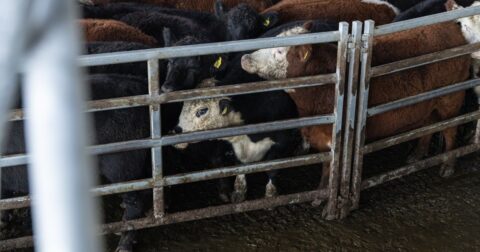Explainer
How Overconsumption Affects the Environment and Health, Explained
Climate•12 min read
Explainer
Beef and dairy production are particularly damaging.


Words by Seth Millstein
Every year, humans consume 70 million metric tons of beef and over 174 million tons of milk. That’s a lot of meat and dairy, and producing it requires many, many cattle farms. Unfortunately, cattle farming leads to significant environmental damage, and absent a serious change in our consumption habits, it will continue to do so.
Cattle are mainly farmed to produce meat and dairy, although many cattle farms also produce leather. While many breeds of cow are classified either as dairy producers or beef producers, there are also “dual-purpose breeds” that are suitable for either, and some cattle farms produce both beef and dairy products.
Let’s take a look at why cattle farming is bad for the environment, and what might be done about it.
Cattle farming is big business. Around 25 percent of land use around the world, and 25 percent of land use conversion, is driven by beef production. The global beef market is worth about $446 billion annually, and the global milk market is worth almost twice that. In any given year, there are between 930 million and a little over one billion heads of cattle around the world.
The U.S. is the world’s leading producer of beef, with Brazil in a close second, and the U.S. is also the third-biggest exporter of beef worldwide. U.S. beef consumption is also high: Americans consume around 30 billion pounds of beef every year.
The regular, daily operations of cattle farms have a number of ruinous environmental consequences on the air, water and soil. This is largely due to the biology of cows and how they digest food, as well as the ways in which farmers deal with the waste and excrement of their cattle.
In addition to this, cattle farms have an enormous impact on the environment before they’re even built, thanks to the staggering amount of forested land that’s destroyed in order to make way for their construction. This is a crucial part of the equation, as cattle-driven deforestation has an immense environmental impact all on its own, but let’s first begin by looking at the direct effects of cattle farm operations.
Cattle farms emit a number of different greenhouse gasses in a number of different ways. The burps, farts and excrement of cows all contain methane, an especially potent greenhouse gas; a single cow produces 82 pounds of manure every day and up to 264 pounds of methane every year. The fertilizer and soil used on cattle farms emits nitrous oxide, and cow manure contains methane, nitrous oxide and carbon dioxide — the “big three” of greenhouse gasses.
Given all of this, it’s probably no surprise that cattle produce more greenhouse gasses every year than any other agricultural commodity.
Cattle farming is also a major source of water pollution, thanks to the toxins contained in manure and other common farm waste. For instance, many cattle farms use the manure from their cows as untreated fertilizer. In addition to the aforementioned greenhouse gasses, cow manure also contains bacteria, phosphates, ammonia and other contaminants. When fertilizer or fertilized soil runs off into nearby waterways — and it often does — so do those contaminants.
This is called nutrient runoff, or diffuse source pollution, and it occurs when rain, wind or other elements inadvertently carry soil into waterways. Globally, cattle produce much more nutrient runoff and subsequent water pollution than any other livestock species. Nutrient runoff is closely related to soil erosion, which we’ll discuss below.
Point source pollution, by contrast, is when a farm, factory or other entity directly dumps waste into a body of water. Unfortunately, this is common on cattle farms as well. As much as 25 percent of point source pollution in the planet’s rivers comes from cattle farms.
Soil is a vital natural resource that makes all human diets — plant- and animal-based alike — possible. Soil erosion is what happens when wind, water or other forces detach topsoil particles and blow or wash them away, thus diminishing the quality of the soil. When soil is eroded, it’s much more susceptible to the aforementioned nutrient runoff.
Although a degree of soil erosion is natural, it’s been greatly accelerated by human activity, specifically livestock farming. One reason for this is overgrazing; often, the pastures on cattle farms aren’t given time to recover after extensive grazing by the cattle, which over time will erode the soil. In addition, the hooves of cattle can erode soil, especially when there are many cows on one plot of land.
There’s a third way in which cattle farms contribute to soil erosion that we’ll discuss below, as cattle farming is intertwined with the much larger phenomenon of deforestation.
All of these direct environmental impacts of cattle farming are bad enough, but we must also take into account all of the environmental damage that makes cattle farms possible in the first place.
Producing beef requires a lot of land — around 60 percent of all agricultural land on the planet, to be precise. Global beef production has doubled since the 1960s, and this has been made possible largely through the wildly destructive practice of deforestation.
Deforestation is when forested land is permanently cleared and repurposed for another use. Around 90 percent of global deforestation is carried out to make way for agricultural expansion, and beef production in particular is the single biggest driver of deforestation in the world by a large margin. Between 2001 and 2015, over 45 million hectares of forested land was cleared and converted into cattle pastures — more than five times as much land as any other agricultural product.
As mentioned earlier, these cattle pastures inflict a tremendous amount of environmental damage on their own, but the deforestation that makes the construction of these farms possible is arguably even worse.
At its heart, deforestation is the removal of trees, and removing trees increases greenhouse gas emissions in two distinct stages. Simply by existing, trees capture carbon from the atmosphere and store it in their bark, branches and roots. This makes them an invaluable (and free!) tool for reducing global temperatures — but when they’re cut down, all of that carbon dioxide is released back into the atmosphere.
But the damage doesn’t end there. The absence of trees on previously forested areas means that any atmospheric carbon dioxide that would have otherwise been sequestered by the trees remains in the air instead.
The result is that deforestation causes both a one-time boost in carbon emissions, when the trees are initially cut down, and a permanent, ongoing increase in emissions, due to the trees’ absense.
It’s estimated that 20 percent of global greenhouse emissions are the result of deforestation in the tropics, which is where 95 percent of deforestation is carried out. The situation is so bad that the Amazon rainforest, which has traditionally been one of the planet’s most important sources of carbon dioxide sequestration, is in danger of instead becoming a “carbon sink” that emits more carbon than it stores.
Another consequence of removing forests is the death of the animals, plants and insects living in that forest. This is called biodiversity loss, and it’s a threat to animals and humans alike.
The Amazon rainforest alone is home to over three million different species, including over a dozen that can only be found in the Amazon. Deforestation, however, causes the extinction of at least 135 species every day, and deforestation in the Amazon threatens to make another 10,000 species, including almost 2,800 animal species, extinct.
We are living amidst a mass extinction, which is a period of time in which species are dying off at a greatly accelerated rate. Over the last 500 years, entire genuses have been going extinct 35 times faster than the historical average, a development scientists have referred to as the “mutilation of the tree of life.” The planet has undergone five mass extinctions in the past, but this is the first one caused primarily by human activity.
Earth’s many interlocking ecosystems are what makes life on this planet possible, and the loss of biodiversity disrupts this delicate equilibrium.
As mentioned earlier, cattle farms often erode the soil solely by virtue of their everyday operations. But when cattle farms are built on deforested land, the effect can be much worse.
When forests are converted to pastures for grazing, as is the case when cattle farms are built on deforested land, the new vegetation often doesn’t hold onto the soil as firmly as the trees did. This leads to more erosion — and by extension, more water pollution from nutrient runoff.
To be sure, cattle farming isn’t the only type of agriculture that exacts a steep environmental cost, as just about every form of animal agriculture is hard on the environment. The agricultural practices on these farms are polluting water, eroding soil and polluting air. The deforestation that makes these farms possible has all those effects as well— while also killing countless animals, plants and insects.
The amount of beef and dairy humans consume is unsustainable. The world population is growing as the world’s forested land is shrinking, and unless we make a serious change to our consumption habits, there will eventually be no more forests left to cut down.